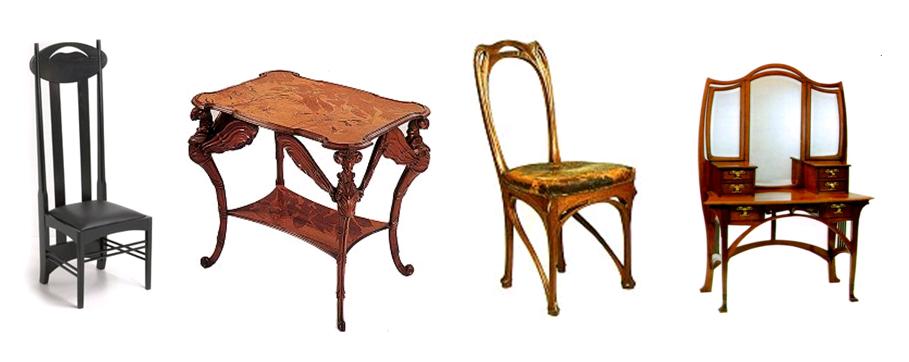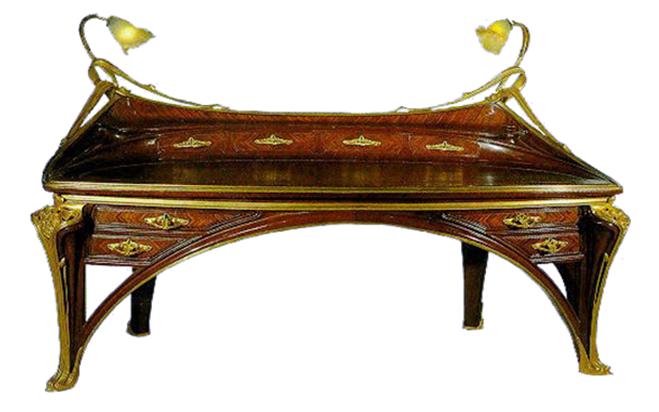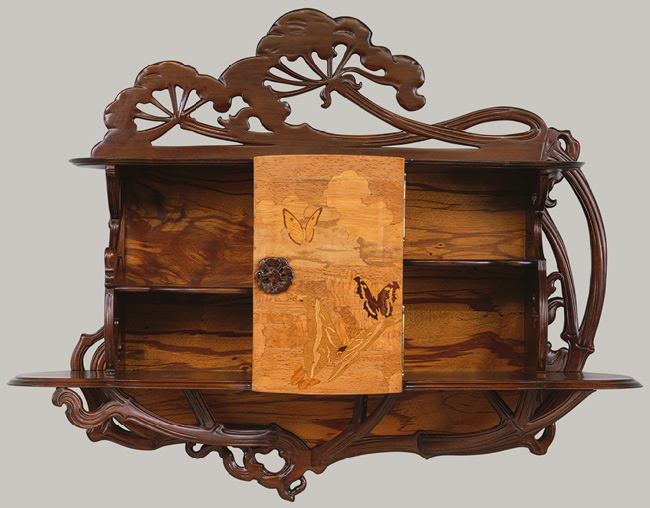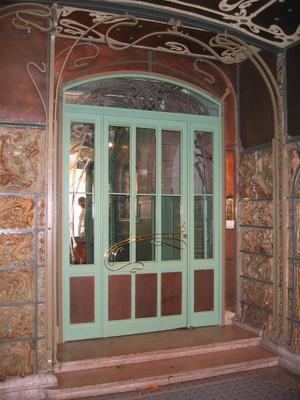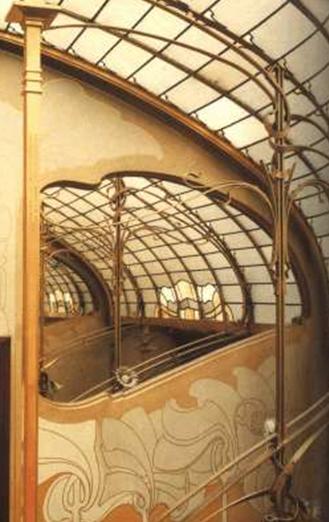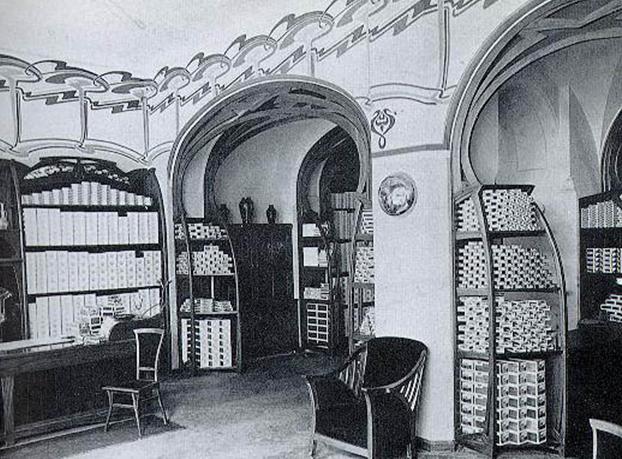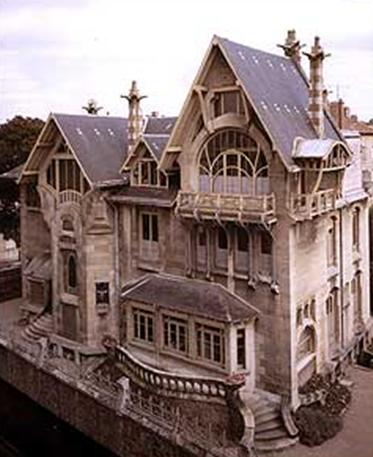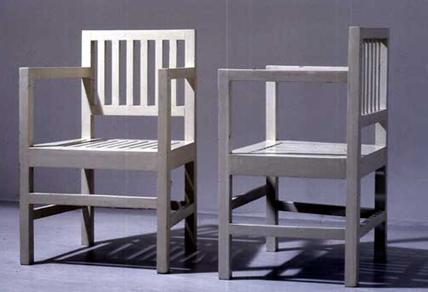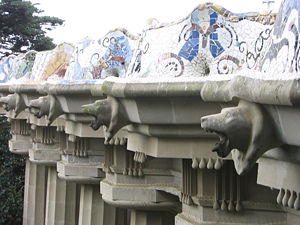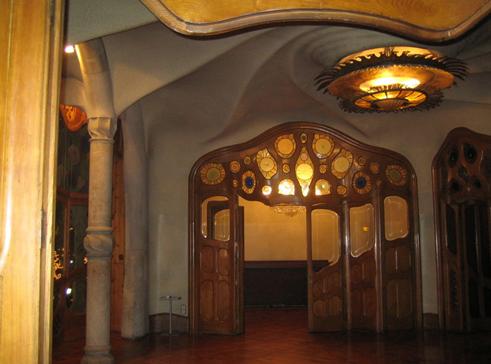Historia Del Diseño Industrial - Tema 2. Art Nouveau

.
- 1.
El Art Nouveau comparte gran parte de la filosofía del movimiento de Artes y oficios, principalmente su vinculación con los gremios de artesanos.
- A.
Verdadero
- B.
Falso
Correct Answer
B. FalsoExplanation
El Art Nouveau no comparte gran parte de la filosofía del movimiento de Artes y oficios, ni está vinculado con los gremios de artesanos. El Art Nouveau fue un movimiento artístico que se desarrolló a finales del siglo XIX y principios del XX, y se caracterizó por su enfoque en la estética y la innovación en el diseño. A diferencia del movimiento de Artes y oficios, el Art Nouveau no tenía una conexión directa con los gremios de artesanos y se centraba más en la creación de obras de arte únicas y originales.Rate this question:
-
- 2.
El principal elemento expresivo del Art Nouveau es
- A.
El Simbolismo
- B.
La forma geométrica y pura
- C.
La línea curva, sinuosa
- D.
Los colores vivos y radiantes
- E.
La figura humana
Correct Answer
C. La línea curva, sinuosaExplanation
The correct answer is "La línea curva, sinuosa". Art Nouveau is known for its use of flowing, organic lines that are often inspired by natural forms such as plants and flowers. These curvilinear lines are used in architecture, furniture, and decorative arts to create a sense of movement and harmony. This style rejected the rigid, straight lines of the previous artistic movements and embraced the fluidity and grace of the curved line.Rate this question:
-
- 3.
Algunas influencias del Art Nouveau proceden de...
- A.
El arte celta
- B.
Los interiores japoneses
- C.
La mitología nórdica
- D.
El barroco clásico
- E.
El arte colonial
Correct Answer(s)
A. El arte celta
B. Los interiores japonesesExplanation
El Art Nouveau fue un movimiento artístico que se desarrolló a finales del siglo XIX y principios del siglo XX. Se caracterizó por su estilo ornamental y la incorporación de elementos naturales y orgánicos en su diseño. Algunas de las influencias del Art Nouveau provienen del arte celta, con su énfasis en las formas curvas y la decoración elaborada. Los interiores japoneses también influyeron en el Art Nouveau, con su enfoque en la simplicidad y la armonía. Estas influencias se pueden ver en las líneas sinuosas y los motivos florales utilizados en el diseño Art Nouveau.Rate this question:
-
- 4.
En el Art Nouveau se busca generalmente...
- A.
Huir de las formas preestablecidas
- B.
Generar una sensación de sosiego relacionada con motivos oníricos
- C.
Transmitir una imagen de volubilidad en el diseño
- D.
Dar sensación de coherencia en el conjunto
- E.
Reflejar la vida en el campo
Correct Answer
D. Dar sensación de coherencia en el conjuntoExplanation
In the Art Nouveau movement, the main objective is to create a sense of coherence in the overall design. This means that all elements and components of the artwork or design should work together harmoniously and create a unified whole. This sense of coherence can be achieved through the use of consistent themes, motifs, and styles throughout the design. By doing so, the Art Nouveau movement aims to create a visually pleasing and balanced composition that is aesthetically pleasing to the viewer.Rate this question:
-
- 5.
Aunque es un movimiento bastante homogéneo, ell Art Nouveau se manifiesta de forma muy diferente en Bélgica, por influencia de la corriente de Artes y Oficios
- A.
Verdadero
- B.
Falso
Correct Answer
B. FalsoExplanation
El movimiento Art Nouveau no se manifiesta de forma muy diferente en Bélgica debido a la influencia de la corriente de Artes y Oficios.Rate this question:
-
- 6.
El principal autor del Art Nouveau escocés es
Correct Answer
Explanation
Charles Rennie Mackintosh. El Art Nouveau escocés fue un movimiento artístico y arquitectónico que se desarrolló en Escocia a finales del siglo XIX y principios del XX. Charles Rennie Mackintosh fue un arquitecto, diseñador y artista escocés que se convirtió en una figura clave en este movimiento. Su estilo distintivo, que combinaba líneas rectas y curvas, así como elementos naturales y geométricos, influyó en el desarrollo del Art Nouveau en Escocia. Mackintosh diseñó varios edificios emblemáticos en Glasgow, como la Escuela de Arte de Glasgow, que se consideran ejemplos destacados del Art Nouveau escocés.Rate this question:
- 7.
La figura de mujer alargada es típica del Art Nouveau
- A.
Francés
- B.
Belga
- C.
Escocés
- D.
Austríaco
Correct Answer
C. EscocésExplanation
The correct answer is "Escocés" because the elongated female figure is a characteristic feature of the Art Nouveau movement, which originated in Scotland.Rate this question:
-
- 8.
La imagen representa una estancia del Salón de Té de Ingram Street, típico diseño Art Nouveau escocés. Se pide citar tres características de esta corriente que se aprecien en la fotografía.
- 9.
¿Quiénes son los autores de los siguientes muebles?
- A.
-
- 10.
El país donde el Art Nouveau recibe su nombre y alcanza su máxima expresión es
Explanation
El Art Nouveau, un estilo artístico y arquitectónico que se caracteriza por sus líneas curvas y ornamentación floral, se originó en Francia a fines del siglo XIX. Fue en este país donde el movimiento recibió su nombre, que significa "arte nuevo" en francés. Francia también fue el lugar donde el Art Nouveau alcanzó su máxima expresión, con la creación de obras maestras arquitectónicas como la Casa Batlló en Barcelona y el Hôtel Tassel en Bruselas. Por lo tanto, Francia es el país donde el Art Nouveau recibe su nombre y alcanza su máxima expresión.Rate this question:
- 11.
En Francia, el movimiento tiene dos centros de acción importantes, que son
Explanation
The correct answer is "París y Nancy, Nancy y París, París y la escuela de Nancy, La escuela de Nancy y París". This answer suggests that in France, there are two important centers of action for the movement, which are Paris and Nancy. It also implies that the school of Nancy is also a significant center for the movement in France.Rate this question:
- 12.
El escritorio de la imagen es un diseño de
- A.
Edouard Colonna
- B.
Victor Horta
- C.
Émile Gallé
- D.
Louis Majorelle
Correct Answer
D. Louis MajorelleExplanation
The correct answer is Louis Majorelle. Louis Majorelle was a French furniture designer and decorator who was known for his Art Nouveau style. He was particularly famous for his intricate designs and use of organic forms and motifs in his furniture. The image of the desk in the question is a design that is consistent with Majorelle's style, featuring elegant curves and floral patterns. Therefore, it can be concluded that the desk in the image is a design by Louis Majorelle.Rate this question:
-
- 13.
INVESTIGACIÓN: El autor del diseño del mueble de la imagen es...
Correct Answer
Émile Gallé
GalléExplanation
The correct answer is Émile Gallé. Émile Gallé was a French artist and designer known for his work in the Art Nouveau style. He was particularly renowned for his furniture designs, which often featured intricate floral motifs and innovative use of materials. The image provided in the question is likely a representation of one of Gallé's furniture designs, which is why he is the correct answer.Rate this question:
- 14.
Explicar los objetivos del Grupo de París, concretados en la galería L'Art Nouveau.
- 15.
La obra más característica de Hector Guimard es...
- A.
La Villa Majorelle
- B.
El Hotel Tassel
- C.
Las estructuras del Metro de París
- D.
El Aparador en Madera de Peral
Correct Answer
C. Las estructuras del Metro de ParísExplanation
Hector Guimard is known for his iconic structures in the Paris Metro. He was a prominent architect and designer during the Art Nouveau movement. His unique and ornate entrances to the Paris Metro stations, characterized by their curvilinear forms and intricate ironwork, are considered some of his most significant works. These structures not only served as functional entrances but also as artistic expressions of the time. They are a testament to Guimard's innovative and influential style, making them the most characteristic work associated with him.Rate this question:
-
- 16.
INVESTIGACIÓN: La puerta de la imagen corresponde a la obra arquitectónica denominada
Correct Answer
Castel BérangerExplanation
The correct answer is Castel Béranger.Rate this question:
- 17.
El Art Nouveau belga es expresivamente similar al francés pero con formas más enérgicas
- A.
Verdadero
- B.
Falso
Correct Answer
B. FalsoExplanation
El Art Nouveau belga no es expresivamente similar al francés, sino que tiene formas más enérgicas.Rate this question:
-
- 18.
El interior que aparece en la imagen es un diseño de...
- A.
Henry Van de Velde
- B.
Paul Hankar
- C.
Louis Majorelle
- D.
Victor Horta
Correct Answer
D. Victor HortaExplanation
The correct answer is Victor Horta. Victor Horta was a Belgian architect and designer who is considered one of the pioneers of the Art Nouveau movement. He is known for his innovative use of iron and glass in his designs, as well as his attention to detail and integration of nature into his work. The image likely depicts an interior that showcases Horta's characteristic style, characterized by organic forms, decorative motifs, and a harmonious blend of materials.Rate this question:
-
- 19.
INVESTIGACIÓN: La imagen representa un diseño de
Correct Answer
Henry Van-de-Velde
Van-de-VeldeExplanation
The image represents a design created by Henry Van-de-Velde. Henry Van-de-Velde was a renowned Belgian architect and designer who played a significant role in the development of the Art Nouveau movement. His designs were characterized by their innovative and artistic approach, often incorporating organic forms and intricate details. Van-de-Velde's work had a significant influence on modern design and architecture, making him a prominent figure in the field.Rate this question:
- 20.
INVESTIGACIÓN: El edificio representado en la imagen fue diseñado por el arquitecto...
Correct Answer
Henri Sauvage
H. SauvageExplanation
The correct answer is Henri Sauvage, H. Sauvage. This answer is based on the information provided in the question, which states that the building in the image was designed by an architect. The names "Henri Sauvage" and "H. Sauvage" are given as options, indicating that either of these names could be the correct answer.Rate this question:
- 21.
Henry Van de Velde influyó con su trabajo en el desarrollo de la corriente denominada
- A.
De Stijl
- B.
Jugendstil
- C.
Werkstätte
- D.
Modernismo
Correct Answer
B. JugendstilExplanation
Henry Van de Velde influyó con su trabajo en el desarrollo de la corriente denominada Jugendstil. Jugendstil, también conocido como Art Nouveau, fue un movimiento artístico y arquitectónico que se desarrolló en Europa a finales del siglo XIX y principios del XX. Van de Velde fue uno de los principales exponentes de este estilo en Bélgica y su trabajo contribuyó significativamente a su difusión y popularidad. El Jugendstil se caracterizó por su estética ornamental y orgánica, con líneas curvas y formas inspiradas en la naturaleza.Rate this question:
-
- 22.
En Austria, el Art Nouveau se vio potenciado por un conjunto de arquitectos y artesanos denominado
- A.
El Grupo de los Cuatro
- B.
La Sociedad de San Jorge
- C.
Ver Sacrum
- D.
La Secesión de Viena
Correct Answer
D. La Secesión de VienaExplanation
The correct answer is "La Secesión de Viena". The Secession of Vienna was a group of artists, including architects and craftsmen, who promoted the Art Nouveau movement in Austria. They aimed to break away from traditional artistic styles and promote a new, modern aesthetic. The Secession of Vienna organized exhibitions and published a journal to showcase their work and ideas. They played a significant role in shaping the Art Nouveau movement in Austria and their influence can still be seen in the architecture and design of Vienna today.Rate this question:
-
- 23.
Las sillas de la imagen son un diseño de...
Correct Answer
Koloman Moser
K. MoserExplanation
The correct answer is Koloman Moser, also known as K. Moser. This suggests that the chairs in the image were designed by this artist.Rate this question:
- 24.
El Art Nouveau americano tiene como principal exponente a
Correct Answer
Louis Comfort-Tiffany
TiffanyExplanation
The correct answer is Louis Comfort-Tiffany. He is considered the main exponent of American Art Nouveau. Tiffany was a renowned artist and designer known for his innovative use of glass in creating beautiful stained glass windows, lamps, and decorative objects. His designs often featured intricate patterns and vibrant colors, reflecting the organic forms and natural motifs that were characteristic of the Art Nouveau style. Tiffany's work had a significant influence on the development of American decorative arts in the late 19th and early 20th centuries.Rate this question:
- 25.
Comparar las dos imágenes en cuanto a las características porpias del Art Nouveau
- 26.
INVESTIGACIÓN: La obra que se representa en la imagen presenta varios corredores o viaductos inspirados en diversos estilos arquitectónicos. ¿Cuál de los siguientes no se reflejado?
- A.
Románico
- B.
Neoclásico
- C.
Gótico
- D.
Barroco
Correct Answer
B. Neoclásico -
- 27.
El interior que se ve en la imagen corresponde al edificio denominado
Correct Answer
Casa BatllóExplanation
The interior shown in the image corresponds to the building known as Casa Batlló.Rate this question:
- 28.
INVESTIGACIÓN: ¿Cuál de los edificios siguientes no pertenece al modernismo valenciano?
- A.
Palacio del Marqués de Dos Aguas
- B.
Estación del Norte
- C.
Mercado Central
- D.
Mercado de Colón
Correct Answer
A. Palacio del Marqués de Dos AguasExplanation
The correct answer is "Palacio del Marqués de Dos Aguas." The other three buildings mentioned, Estación del Norte, Mercado Central, and Mercado de Colón, are all examples of modernist architecture in Valencia. However, the Palacio del Marqués de Dos Aguas is a Baroque-style building and does not belong to the modernist movement.Rate this question:
-
- 29.
Revisar la silla diseñada por Mackmurdo (Tema 1) y comentar qué características del Art Nouveau aparecen ya en la misma.
Quiz Review Timeline +
Our quizzes are rigorously reviewed, monitored and continuously updated by our expert board to maintain accuracy, relevance, and timeliness.
-
Current Version
-
Mar 20, 2023Quiz Edited by
ProProfs Editorial Team -
Jan 08, 2009Quiz Created by
Jalcaide
 Back to top
Back to top




